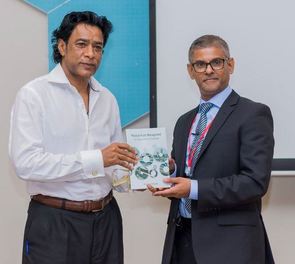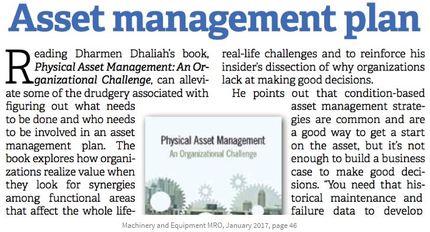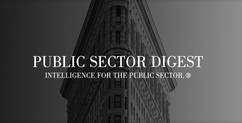Book launch in Republic of Mauritius

My book "Physical Asset Management-An Organizational Challenge" was officially launched on June 21, 2017 by the Minister of Public Infrastructure and Land Transport of Mauritius, Honorable Nandcoomar Bodha. The event took place at the Hennessy Park Hotel, Ebène, Mauritius.
After the book launch ceremony there was a 1-day workshop on "Holistic Physical Asset Management - The Strategic & Tactical Perspective", hosted by Parker Randall Business School and facilitated by Dharmen Dhaliah. The book launching event and workshop were well attended and reported in the media. Below is a link to the Mauritius Broadcasting Corporation Radio/TV website.
After the book launch ceremony there was a 1-day workshop on "Holistic Physical Asset Management - The Strategic & Tactical Perspective", hosted by Parker Randall Business School and facilitated by Dharmen Dhaliah. The book launching event and workshop were well attended and reported in the media. Below is a link to the Mauritius Broadcasting Corporation Radio/TV website.
Asset Management Plan

Published on February 24, 2017 - Rehana BeggEditor, Machinery and Equipment MRO and REM - Resource Engineering and Maintenance magazines at Annex Business Media
Reading Dharmen Dhaliah’s book, Physical Asset Management: An Organizational Challenge, can alleviate some of the drudgery associated with figuring out what needs to be done and who needs to be involved in an asset management plan. The book explores how organizations realize value when they analyze synergies among functional areas that affect the entire lifecycle of their assets.
The first-time author advocates for a higher-level, strategic approach to managing physical assets. “When you ask many in the industry, they’ll say that they practice asset management, but when you dig deeper, you’ll realize there are many gaps. For example, how many of us care about the assets that we don’t use anymore? As an organization, do they dispose of it correctly?”
Dhaliah argues that asset management is a strategic approach but that organizations tend to practise it piecemeal, and often with either a bottom-up or top-down approach. “What we’ve been doing so far is address pieces of the puzzle, by applying good practices at the tactical level. We need a higher-level approach, a strategic approach, to bring everything together to make sure we are covering all aspects of the asset lifecycle.”
Dhaliah, an asset manager with the City of Toronto and a member of the Technical Committee 251 for the ISO 55000 standards, draws from firsthand knowledge and industry observations to construct case studies that replicate real-life challenges and to reinforce his insider’s dissection of why organizations lack at making good decisions.
He points out that condition-based asset management strategies are common and are a good way to get a start on the asset, but it is not enough to build a business case to make good decisions. “You need historical maintenance and failure data to develop lifecycle costs, to understand performance standards and to implement asset design when you start to put new equipment in place. These all come from the bottom-up support, where you will find the maintenance data in the CMMS or work management systems…”
A host of credentials as a registered professional mechanical engineer, Certified Asset Management Assessor and Certified Maintenance and Reliability Professional, allow Dhaliah to pay it forward. Not only does Dhaliah teach online courses in maintenance management and asset management, but he also relies on his network to provide a veritable list of sources that help maintenance professionals uncover gaps in their processes and expose fault lines that hinder harmonization as they grapple with mapping out holistic asset lifecycle management systems.
Physical Asset Management: An Organizational Challenge, by Dharmen Dhaliah is available from the FriesenPress Bookstore and Amazon, as well Dhaliah’s website: http://www.dharmendhaliah.com/.
For more book reviews and trends in physical asset management, visit www.mromagazine.com.
Reading Dharmen Dhaliah’s book, Physical Asset Management: An Organizational Challenge, can alleviate some of the drudgery associated with figuring out what needs to be done and who needs to be involved in an asset management plan. The book explores how organizations realize value when they analyze synergies among functional areas that affect the entire lifecycle of their assets.
The first-time author advocates for a higher-level, strategic approach to managing physical assets. “When you ask many in the industry, they’ll say that they practice asset management, but when you dig deeper, you’ll realize there are many gaps. For example, how many of us care about the assets that we don’t use anymore? As an organization, do they dispose of it correctly?”
Dhaliah argues that asset management is a strategic approach but that organizations tend to practise it piecemeal, and often with either a bottom-up or top-down approach. “What we’ve been doing so far is address pieces of the puzzle, by applying good practices at the tactical level. We need a higher-level approach, a strategic approach, to bring everything together to make sure we are covering all aspects of the asset lifecycle.”
Dhaliah, an asset manager with the City of Toronto and a member of the Technical Committee 251 for the ISO 55000 standards, draws from firsthand knowledge and industry observations to construct case studies that replicate real-life challenges and to reinforce his insider’s dissection of why organizations lack at making good decisions.
He points out that condition-based asset management strategies are common and are a good way to get a start on the asset, but it is not enough to build a business case to make good decisions. “You need historical maintenance and failure data to develop lifecycle costs, to understand performance standards and to implement asset design when you start to put new equipment in place. These all come from the bottom-up support, where you will find the maintenance data in the CMMS or work management systems…”
A host of credentials as a registered professional mechanical engineer, Certified Asset Management Assessor and Certified Maintenance and Reliability Professional, allow Dhaliah to pay it forward. Not only does Dhaliah teach online courses in maintenance management and asset management, but he also relies on his network to provide a veritable list of sources that help maintenance professionals uncover gaps in their processes and expose fault lines that hinder harmonization as they grapple with mapping out holistic asset lifecycle management systems.
Physical Asset Management: An Organizational Challenge, by Dharmen Dhaliah is available from the FriesenPress Bookstore and Amazon, as well Dhaliah’s website: http://www.dharmendhaliah.com/.
For more book reviews and trends in physical asset management, visit www.mromagazine.com.

http://reliabilityweb.com/news/article/preventing-chaos-with-a-holistic-asset-management-approach
Preventing Chaos With a Holistic Asset Management Approach/Engineer/Business Professional Proposes Organizational Paradigm Shift, Mississauga, ONT. – 10 January 2017
While many might not fully realize it, people depend on physical assets and infrastructure every day for essential services such as transportation, power, water, and communication. Without proper management of these assets and infrastructure, chaos occurs. In some of the worst case scenarios, bridges collapse, mall roofs cave in, commuter trains derail, dams fail, just to name a few. Now, with the aim to help asset management practitioners and organizations in general overcome obstacles and avoid oversights, author Dharmen Dhaliah brings his expertise on the matter (including 26 years of experience) to his newly published book, Physical Asset Management: An Organizational Challenge.
Dharmen Dhaliah's Physical Asset Management: An Organizational Challenge, produced by FriesenPress, offers recommendations and guidance to efficient physical asset management. A holistic approach to managing physical assets has become a top priority for organizations both in the public and private sectors, but Dharmen outlines a single key oversight: how will organizations cope with its implementation to realize maximum value? Physical Asset Management: An Organizational Challenge explores how the holistic physical asset management philosophy fits within an organization, details the challenges it faces, and analyzes the various synergies required among functional areas dealing with physical assets. Existing gaps and overlaps over the whole lifecycle of physical assets are also uncovered, exposing those that hinder collaboration and harmonization.
Physical Asset Management: An Organizational Challenge by Dharmen Dhaliah is available for order from major online book retailers, including the FriesenPress Bookstore and Amazon, as well as on Dharmen’s website: http://www.dharmendhaliah.com/.
Preventing Chaos With a Holistic Asset Management Approach/Engineer/Business Professional Proposes Organizational Paradigm Shift, Mississauga, ONT. – 10 January 2017
While many might not fully realize it, people depend on physical assets and infrastructure every day for essential services such as transportation, power, water, and communication. Without proper management of these assets and infrastructure, chaos occurs. In some of the worst case scenarios, bridges collapse, mall roofs cave in, commuter trains derail, dams fail, just to name a few. Now, with the aim to help asset management practitioners and organizations in general overcome obstacles and avoid oversights, author Dharmen Dhaliah brings his expertise on the matter (including 26 years of experience) to his newly published book, Physical Asset Management: An Organizational Challenge.
Dharmen Dhaliah's Physical Asset Management: An Organizational Challenge, produced by FriesenPress, offers recommendations and guidance to efficient physical asset management. A holistic approach to managing physical assets has become a top priority for organizations both in the public and private sectors, but Dharmen outlines a single key oversight: how will organizations cope with its implementation to realize maximum value? Physical Asset Management: An Organizational Challenge explores how the holistic physical asset management philosophy fits within an organization, details the challenges it faces, and analyzes the various synergies required among functional areas dealing with physical assets. Existing gaps and overlaps over the whole lifecycle of physical assets are also uncovered, exposing those that hinder collaboration and harmonization.
Physical Asset Management: An Organizational Challenge by Dharmen Dhaliah is available for order from major online book retailers, including the FriesenPress Bookstore and Amazon, as well as on Dharmen’s website: http://www.dharmendhaliah.com/.

http://publicsectordigest.com/article/preventing-chaos-holistic-asset-management-approach
While many might not fully realize it, people depend on physical assets and infrastructure every day for essential services such as transportation, power, water, and communication. Without proper management of these assets and infrastructure, chaos occurs. In some of the worst case scenarios, bridges collapse, mall roofs cave in, commuter trains derail, dams fail, just to name a few. Now, with the aim to help asset management practitioners and organizations in general overcome obstacles and avoid oversights, author Dharmen Dhaliah brings his expertise on the matter (including 26 years of experience) to his newly published book, Physical Asset Management: An Organizational Challenge.
Dharmen Dhaliah's Physical Asset Management: An Organizational Challenge, produced by FriesenPress, offers recommendations and guidance to efficient physical asset management. A holistic approach to managing physical assets has become a top priority for organizations both in the public and private sectors, but Dharmen outlines a single key oversight: how will organizations cope with its implementation to realize maximum value?
Physical Asset Management: An Organizational Challenge explores how the holistic physical asset management philosophy fits within an organization, details the challenges it faces, and analyzes the various synergies required among functional areas dealing with physical assets. Existing gaps and overlaps over the whole lifecycle of physical assets are also uncovered, exposing those that hinder collaboration and harmonization.
Physical Asset Management: An Organizational Challenge is available for order from major online book retailers, including the FriesenPress Bookstore and Amazon, as well as on Dharmen’s website: http://www.dharmendhaliah.com/.
While many might not fully realize it, people depend on physical assets and infrastructure every day for essential services such as transportation, power, water, and communication. Without proper management of these assets and infrastructure, chaos occurs. In some of the worst case scenarios, bridges collapse, mall roofs cave in, commuter trains derail, dams fail, just to name a few. Now, with the aim to help asset management practitioners and organizations in general overcome obstacles and avoid oversights, author Dharmen Dhaliah brings his expertise on the matter (including 26 years of experience) to his newly published book, Physical Asset Management: An Organizational Challenge.
Dharmen Dhaliah's Physical Asset Management: An Organizational Challenge, produced by FriesenPress, offers recommendations and guidance to efficient physical asset management. A holistic approach to managing physical assets has become a top priority for organizations both in the public and private sectors, but Dharmen outlines a single key oversight: how will organizations cope with its implementation to realize maximum value?
Physical Asset Management: An Organizational Challenge explores how the holistic physical asset management philosophy fits within an organization, details the challenges it faces, and analyzes the various synergies required among functional areas dealing with physical assets. Existing gaps and overlaps over the whole lifecycle of physical assets are also uncovered, exposing those that hinder collaboration and harmonization.
Physical Asset Management: An Organizational Challenge is available for order from major online book retailers, including the FriesenPress Bookstore and Amazon, as well as on Dharmen’s website: http://www.dharmendhaliah.com/.
